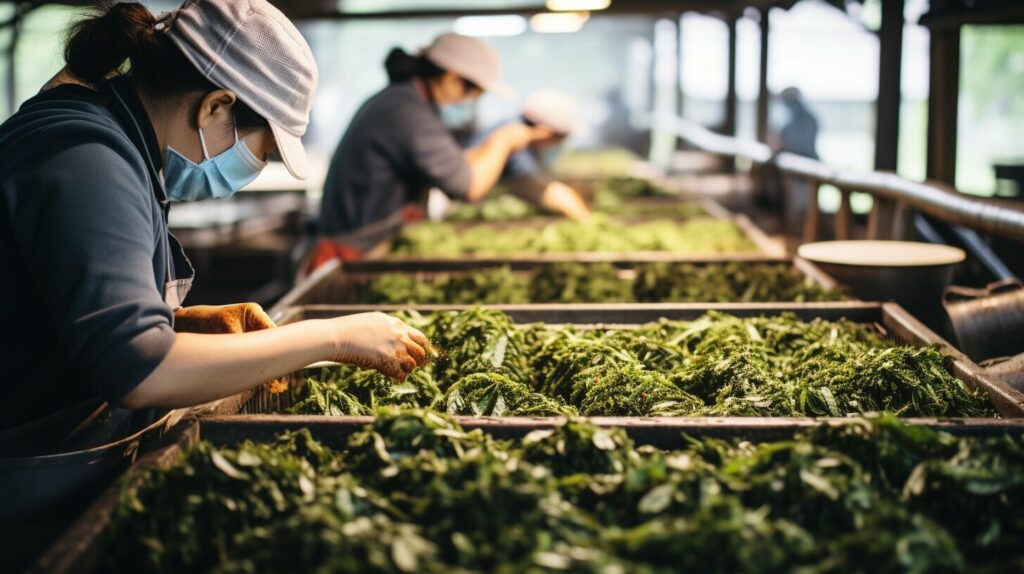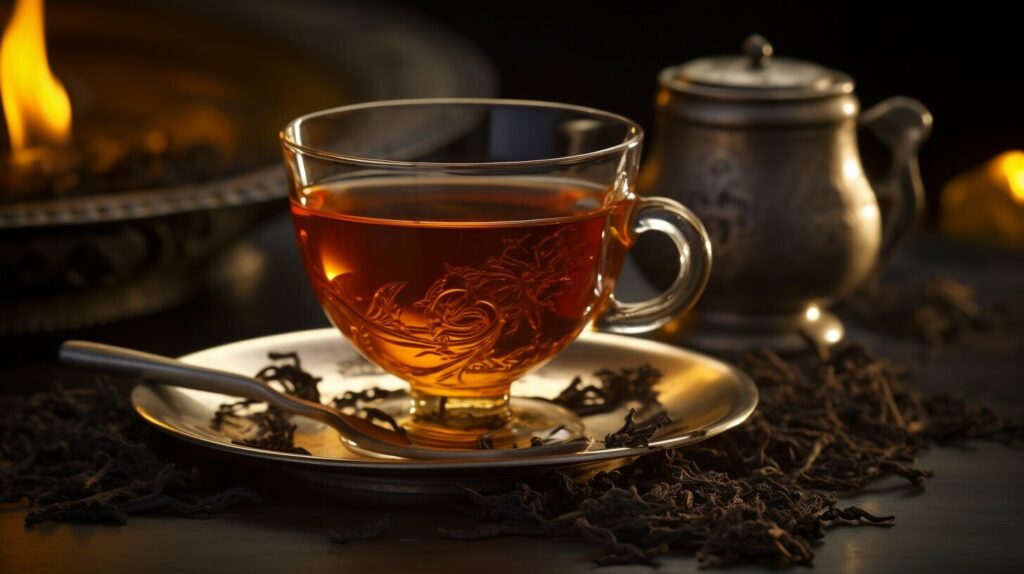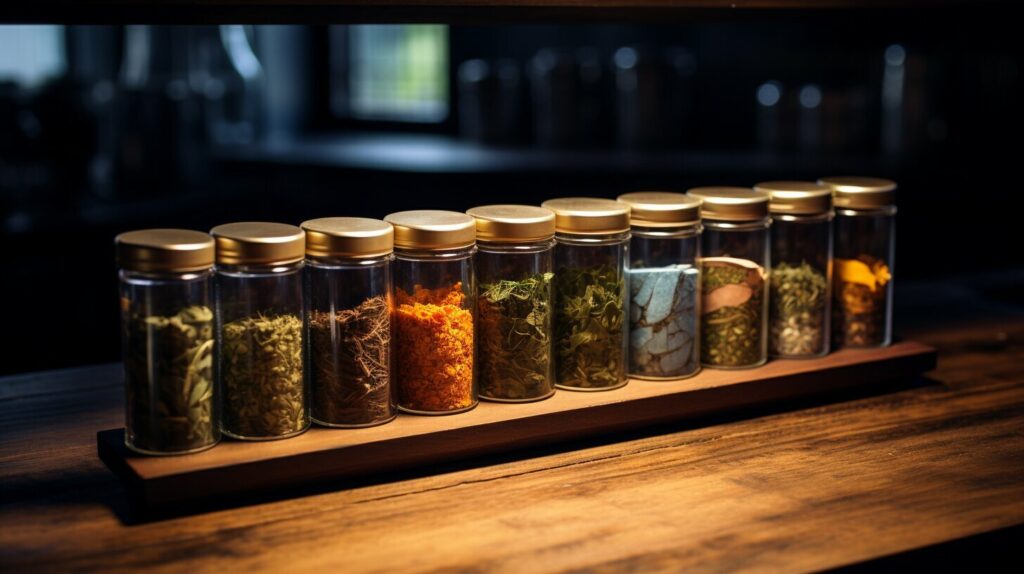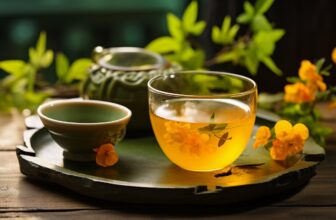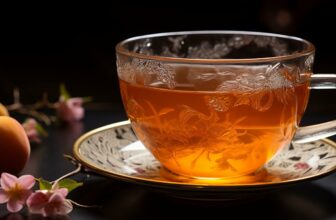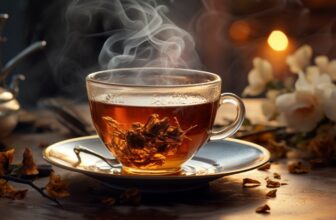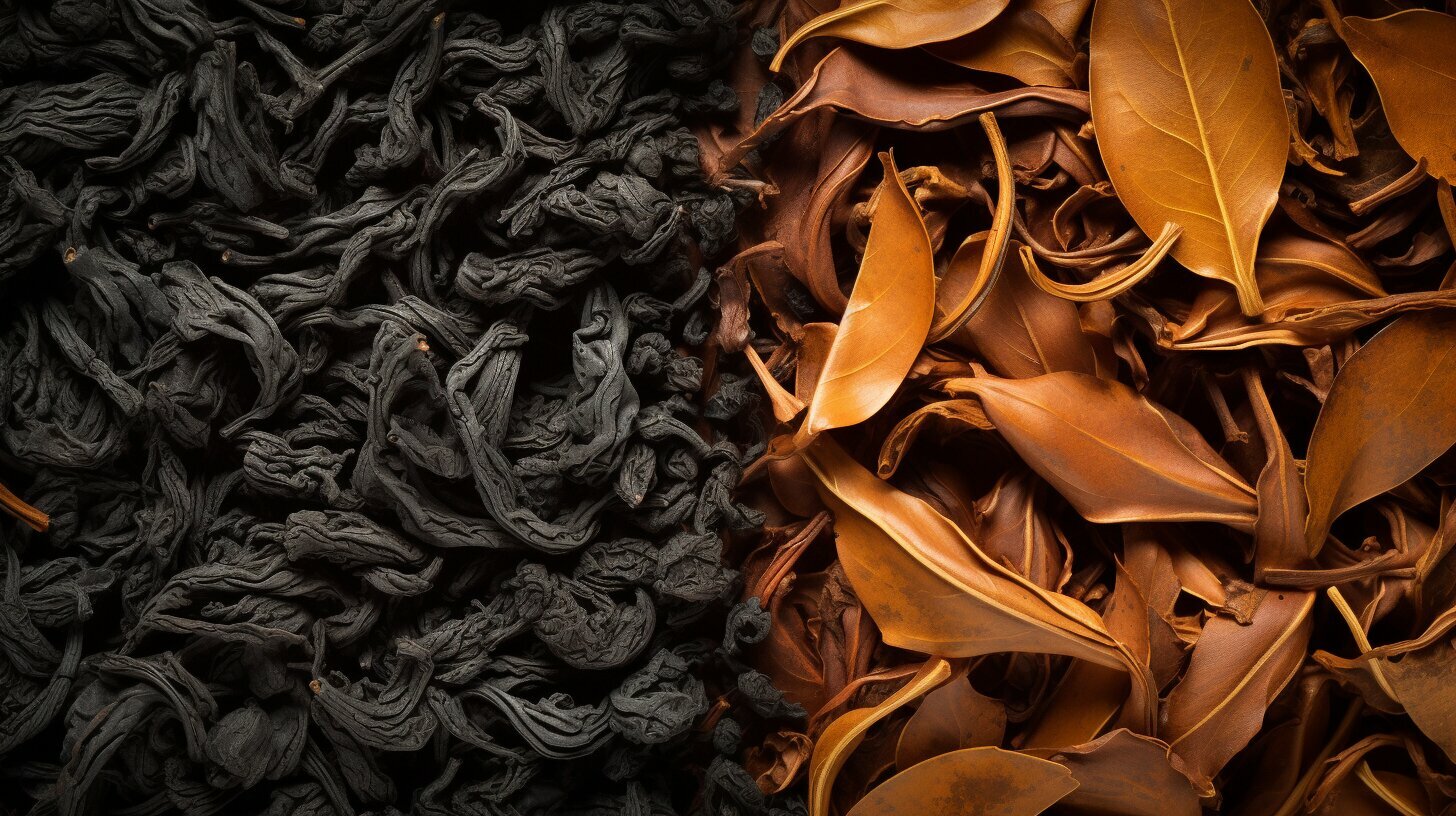
When it comes to tea, there are many varieties to explore and enjoy. Oolong tea is a unique type of tea that often raises questions, particularly regarding its similarity to black tea. In this article, I will delve into the facts surrounding oolong tea and unravel the similarities and differences between oolong and black tea. Let’s explore what makes oolong tea different from black tea and how to distinguish the two.
Key Takeaways:
- Oolong tea is not the same as black tea and falls into its own category
- Oolong tea can have varying degrees of oxidation, resulting in different flavor profiles
- The shape of oolong tea leaves is often rolled, twisted, or curled
- Oolong teas are produced in both China and Taiwan, each with their own unique styles
- Understanding the differences between oolong and black tea can enhance your tea-drinking experience
The Processing of Oolong Tea
Oolong tea, with its unique flavor profile and distinctive characteristics, undergoes a meticulous processing method that involves several essential steps.
1. Withering: Immediately after being plucked, the tea leaves are carefully bruised and spread out to dry, allowing them to lose moisture and undergo partial oxidation. This crucial step helps to develop the tea’s complex flavors.
2. Rolling: Following withering, the leaves are gently rolled, twisted, or curled to release their enzymes and initiate oxidation. This rolling process shapes the leaves and further contributes to the tea’s taste and appearance.
3. Oxidizing: The rolled leaves are exposed to oxygen, enabling them to undergo oxidation. The length of oxidation will determine the level of flavor complexity and aroma. The tea master closely monitors this stage to ensure the desired outcome.
4. Roasting: After oxidation, the leaves are subjected to roasting or firing, which halts the enzymatic activity and sets the final flavor profile. Roasting can range from light to heavy, each imparting its unique characteristics to the tea.
5. Drying: The last step involves thoroughly drying the processed leaves to remove any remaining moisture. This step helps to preserve the tea’s freshness and enhances its shelf life.
This intricate process of withering, rolling, oxidizing, roasting, and drying is meticulously conducted by experienced tea artisans. Each step contributes to the intricate flavors, appearance, and aroma that make oolong tea a unique and sought-after beverage.
Oolong Tea Varieties and Flavors
Oolong teas offer a wide range of varieties, each with its own distinct flavor profile. From delicate and floral to rich and robust, there is an oolong tea to suit every taste preference. Let’s explore some of the different types of oolong tea and the flavors they have to offer.
Green Oolong
Green oolong teas are lightly oxidized, resulting in a fresh and vibrant flavor. They often have a delicate sweetness with floral and vegetal notes. Green oolong teas are known for their bright green liquor and smooth, buttery texture. They are a great choice for those who prefer a lighter and more refreshing cup of tea.
Medium Oxidation Oolong
Medium oxidation oolongs strike a balance between the lighter green oolongs and the darker roasted oolongs. They offer a wide range of flavors, from floral and fruity to nutty and honeyed. These oolongs often have a smooth and creamy texture with a lingering sweet aftertaste. The complexity of flavors in medium oxidation oolongs makes them a favorite among oolong enthusiasts.
Medium Roast Oolong
Medium roast oolongs undergo a gentle roasting process that imparts warm and toasty flavors. They often have notes of caramel, nuts, and spices, with a smooth and rounded mouthfeel. The roasting process adds depth and complexity to the tea, resulting in a rich and satisfying cup. Medium roast oolongs are a great choice for those seeking a balance between the lighter and darker oolongs.
Heavy Roast Oolong
Heavy roast oolongs are deeply roasted, resulting in bold and robust flavors. These oolongs have a dark brown liquor with a smoky aroma and a pronounced roasted taste. Notes of chocolate, charcoal, and tobacco are often present in heavy roast oolongs. They offer a full-bodied and deeply satisfying tea experience, perfect for those who enjoy strong and intense flavors.
Table: Types of Oolong Tea and Their Flavor Profiles
| Oolong Tea Variety | Flavor Profile |
|---|---|
| Green Oolong | Delicate, floral, buttery |
| Medium Oxidation Oolong | Floral, fruity, nutty, honeyed |
| Medium Roast Oolong | Caramel, nutty, spicy |
| Heavy Roast Oolong | Smoky, roasted, chocolate, tobacco |
These are just a few examples of the diverse flavors you can find in oolong teas. Whether you prefer a light and floral cup or a bold and robust brew, there is an oolong tea variety to satisfy your palate. Explore the world of oolong teas and discover the unique flavors that they have to offer.
Black Oolong Tea: A Fusion of Flavors
Black oolong tea offers a unique and captivating flavor profile that combines the best characteristics of oolong and black tea. With its origins in Taiwan, this tea showcases a fusion of traditional oolong processing techniques with the rich and malty flavors of black tea. The result is a truly exceptional tea that delights the senses.
The appearance of black oolong tea is visually striking, with dark, tightly rolled leaves that unfurl during brewing to reveal their full beauty. The aroma is complex and inviting, featuring floral and fruity notes from the oolong leaves, along with the deep and robust fragrance of black tea. This combination of scents sets the stage for a truly memorable tea-drinking experience.
Brewing black oolong tea is an art in itself. The recommended brewing temperature is around 195°F (90°C) for a steeping time of 3-4 minutes. This allows the flavors to fully develop, resulting in a balanced cup of tea that showcases the unique characteristics of black oolong. Whether enjoyed hot or iced, black oolong tea offers a rich and satisfying taste that lingers on the palate.
| Appearance | Aroma | Brewing Temperature | Steeping Time |
|---|---|---|---|
| Dark, tightly rolled leaves | Complex blend of floral and fruity notes with a deep, robust fragrance | 195°F (90°C) | 3-4 minutes |
Due to the specialized processing methods required to create black oolong tea, it is a limited production tea. This rarity adds to its allure and makes it a sought-after choice for tea connoisseurs. The intricate flavors and exquisite aroma of black oolong tea make it a delightful addition to any tea collection, offering a truly unique and memorable tea-drinking experience.
Discover the Fusion of Flavors
Black oolong tea is a true masterpiece that combines the best of both worlds – the delicate and nuanced flavors of oolong tea and the robust richness of black tea. Its visually striking appearance, complex aroma, and exquisite taste make it a tea that is sure to impress. So sit back, relax, and indulge in the fusion of flavors that black oolong tea has to offer.
Caffeine Content and Health Benefits of Oolong Tea
Oolong tea is known for its unique flavor and aroma, but it also offers several potential health benefits. One important factor to consider is the caffeine content in oolong tea. Unlike black tea, which is fully oxidized and generally has higher caffeine levels, oolong tea falls somewhere in between black tea and green tea in terms of caffeine content. The exact caffeine levels can vary depending on factors such as the oxidation level and processing of the tea.
For those looking to reduce their caffeine intake, oolong tea can be a great alternative to black tea without completely eliminating caffeine from their diet. It provides a moderate energy boost without the jitters often associated with higher caffeine beverages. Additionally, oolong tea contains L-theanine, an amino acid that may help promote relaxation and calmness, balancing out the stimulating effects of caffeine.
In addition to its caffeine content, oolong tea is believed to offer a range of health benefits. Some studies suggest that regularly drinking oolong tea may help with weight management by boosting metabolism and promoting fat oxidation. It is also thought to have potential cardiovascular benefits, including reducing the risk of heart disease and lowering blood pressure. Furthermore, oolong tea is known to contain antioxidants that can help protect the body against free radicals and oxidative stress.
It’s important to note that while oolong tea may offer potential health benefits, it should be consumed as part of a balanced diet and healthy lifestyle. As with any caffeinated beverage, it’s advisable to consume oolong tea in moderation and be mindful of caffeine sensitivity. Consulting with a healthcare professional is recommended for those with specific health concerns or conditions.
| Health Benefits of Oolong Tea |
|---|
| Potential weight management aid |
| Promotes cardiovascular health |
| Rich in antioxidants |
| May support relaxation and calmness |
Buying and Storing Oolong Tea
When it comes to buying oolong tea, online retailers that specialize in loose leaf teas are an excellent option. They offer a wide selection of oolong teas, allowing you to explore different varieties and flavors. It’s important to choose reputable retailers that provide detailed information about the tea’s origin, processing method, and flavor profile. This knowledge will help you make an informed choice based on your preferences.
When buying oolong tea online, consider purchasing smaller quantities or sampler packs. This allows you to try a variety of flavors before committing to larger purchases. It’s an effective way to discover your favorite oolong teas without being overwhelmed by a large quantity of one particular variety.
Proper storage is essential to maintain the freshness and flavor of oolong tea. It’s recommended to store oolong tea in a cool, dark place away from direct sunlight, moisture, and strong odors. Using airtight containers or resealable bags can help preserve the tea’s aroma and prevent it from absorbing unwanted flavors. Avoid storing oolong tea in the refrigerator or freezer, as the moisture can negatively impact its quality.
By following these tips for buying and storing oolong tea, you can enjoy a delightful and flavorful tea experience. Remember to choose reliable online retailers, explore different varieties, and store your oolong tea properly to savor its unique taste and aroma.
| Tips for Buying Oolong Tea Online | Storage Tips for Oolong Tea |
|---|---|
|
|
“Choosing reputable retailers and considering smaller quantities or sampler packs can make your oolong tea buying experience enjoyable and exploratory. Proper storage in a cool, dark place using airtight containers or resealable bags will preserve the freshness and aroma of your oolong tea.”
Conclusion
In conclusion, oolong tea and black tea are distinct categories of tea with their own unique characteristics. Oolong tea, falling somewhere between black tea and green tea, offers a wide range of flavor profiles due to varying oxidation levels. Its traditional shape, rolled or curled, sets it apart from other teas.
Black oolong tea, a fusion of oolong and black tea processing methods, provides a delightful combination of floral and fruity flavors with the malty and robust qualities of black tea. Taiwan is renowned for its exceptional black oolong teas, which have visually striking appearances and complex aromas.
By exploring the world of oolong tea, tea enthusiasts can unravel the facts and appreciate the differences between oolong and black tea. Whether it’s the distinctive flavors, the health benefits, or the experience of buying and brewing oolong tea, this unique beverage offers a delightful journey for tea lovers.
FAQ
Is oolong tea the same as black tea?
No, oolong tea is not the same as black tea. It falls into its own category of tea, with different oxidation levels and flavor profiles.
What makes oolong tea different from black tea?
The main differences between oolong tea and black tea lie in their oxidation levels and processing methods. Oolong tea can have varying levels of oxidation, resulting in a range of flavors.
How is oolong tea made?
Oolong tea goes through a series of processing steps, including withering, rolling, oxidizing, roasting, and drying. Each step contributes to the final flavor, appearance, and aroma of the tea.
What are the varieties and flavors of oolong tea?
Oolong tea comes in various varieties, including green oolong, medium oxidation oolong, medium roast oolong, and heavy roast oolong. Each variety offers its own unique flavor profile.
What is black oolong tea?
Black oolong tea is a fusion of oolong and black tea processing methods. It combines the floral and fruity notes of oolong with the malty and robust flavors of black tea.
What is the caffeine content of oolong tea?
The caffeine content in oolong tea falls between that of black tea and green tea. It can vary based on the oxidation level and processing of the tea.
What are the health benefits of oolong tea?
Oolong tea offers potential health benefits such as improved heart health, better brain function, and weight management. It can be enjoyed daily, but it’s important to be mindful of caffeine intake.
How should I buy and store oolong tea?
When buying oolong tea online, choose reputable retailers that specialize in loose leaf teas. Store oolong tea properly in a cool, dark place to maintain its freshness. Buying smaller quantities or sampler packs can help you discover your favorite flavors.
What are the similarities and differences between oolong tea and black tea?
Oolong tea and black tea are distinct categories of tea, with oolong falling somewhere in between. The oxidation levels, shape, and processing techniques give oolong tea its unique characteristics and flavor profiles.
Source Links
- https://www.teatulia.com/tea-varieties/what-is-oolong-tea.htm
- https://tecompanytea.com/blogs/tea-atelier/guide-buying-oolong-tea-online
- https://www.jeytea.com.tw/l/black-oolong-tea/
